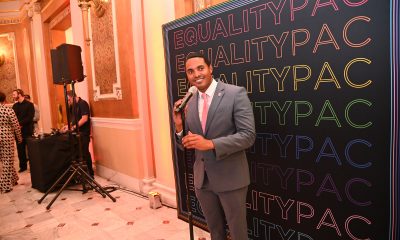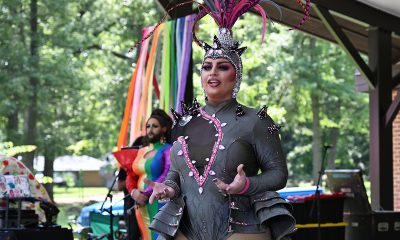Books
True-life arson mystery ignites ‘The Library Book’
Los Angeles 1986 incident brought to life in gripping tale
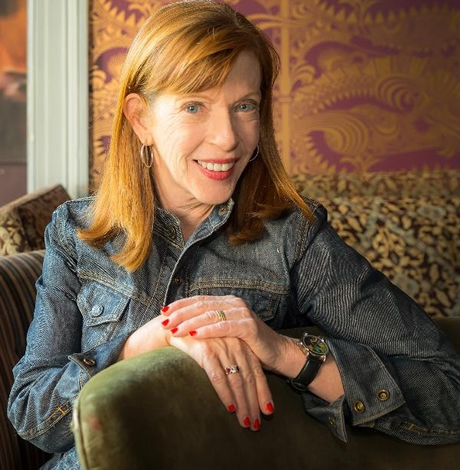
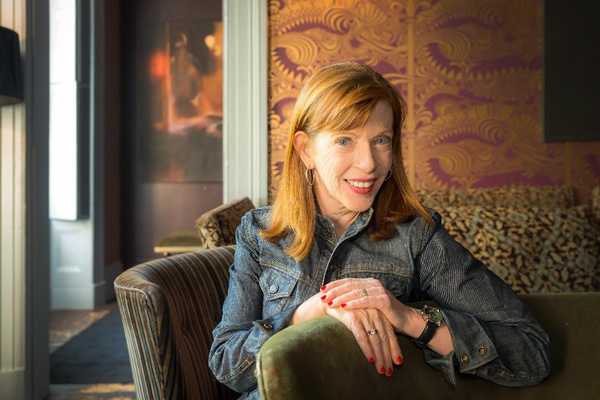
Susan Orlean (Photo courtesy of Simon & Schuster)
The possibilities seem endless.
Row upon row of books awaits you, each representing a fact to learn, a crime to solve, a future to visit, a place to explore or a life to share. Your local library holds old tales and new stories but in “The Library Book” by Susan Orlean, it can hold a community together, too.
The fire alarm was known to be faulty at the Los Angeles Public Library. It was always going off for no reason; patrons knew it, as did staff. So when the alarm screamed again on the morning of April 28, 1986, most people there vacated the library with an air of unconcerned been-there-done-this.
Within minutes, it became obvious this was no false alarm.
Because of how the library had been constructed decades prior, what started as a small fire in a small area soon became a conflagration. Boosted by architecture, the fire fed on itself until, mere hours later, millions of books, manuscripts, priceless documents, maps, collector’s items and operating equipment were lost. It was the largest library fire at that time in the United States.
Throughout its existence, the library had seen its share of history within the city. It had become a beloved home for bookworms, a resource for the homeless and a place for learning. Recognizing what its loss could represent, Los Angelinos sprang into action, filmmakers made donations, citizens held fundraisers and institutions around the world showed their support. Alas, many of the materials were lost forever.
In the days after the fire, tips poured in and one of them led investigators to Harry Peak, a charming gay “people pleaser” who was also unreliable. Peak ultimately confessed to the crime of arson.
And then he unconfessed. In months to come, in fact, he changed his story as easily as he changed clothes, baffling authorities. Was Harry Peak a firebug? Or was he just a guy who craved attention and would stretch a story to get it?
Here’s why you’re going to fall in love with author Susan Orlean: in her quest for full knowledge on this subject, she decided to burn a book (gasp!), a task that gave her knife-sharp anguish that only a book lover can know. Indeed, much of this account will hurt your soul, if you’re someone who loves books.
But that’s not all you’ll find in “The Library Book.”
While crime solving itself is fascinating, Orlean takes her book to a most satisfying next step, and reading it is like wearing a piece of jewelry: the story of the fire and its aftermath is the gold at the base, holding everything together — irresistible, but not quite enough. Orlean’s curiosity for and explanations of the inner workings of a large library are the jewels. They are what make this book sparkle.
Book lovers and library users should read it for its behind-the-scenes, not-so secrets. This book seems meant just for you who adore the written word, so clear your calendar and open “The Library Book.”
You know where to find a copy.

You’re going to be on your feet a lot this month.
Marching in parades, dancing in the streets, standing up for people in your community. But you’re also likely to have some time to rest and reflect – and with these great new books, to read.
First, dip into a biography with “Marsha: The Joy and Defiance of Marsha P. Johnson” by Tourmaline (Tiny Rep Books, $30), a nice look at an icon who, rumor has it, threw the brick that started a revolution. It’s a lively tale about Marsha P. Johnson, her life, her activism before Stonewall and afterward. Reading this interesting and highly researched history is a great way to spend some time during Pride month.
For the reader who can’t live without music, try “The Dad Rock That Made Me a Woman” by Niko Stratis (University of Texas Press, $27.95), the story of being trans, searching for your place in the world, and finding it in a certain comfortable genre of music. Also look for “The Lonely Veteran’s Guide to Companionship” by Bronson Lemer (University of Wisconsin Press, $19.95), a collection of essays that make up a memoir of this and that, of being queer, basic training, teaching overseas, influential books, and life.
If you still have room for one more memoir, try “Walk Like a Girl” by Prabal Gurung (Viking, $32.00). It’s the story of one queer boy’s childhood in India and Nepal, and the intolerance he experienced as a child, which caused him to dream of New York and the life he imagined there. As you can imagine, dreams and reality collided but nonetheless, Gurung stayed, persevered, and eventually became an award-winning fashion designer, highly sought by fashion icons and lovers of haute couture. This is an inspiring tale that you shouldn’t miss.
No Pride celebration is complete without a history book or two.
In “Trans History: From Ancient Times to the Present Day” by Alex L. Combs & Andrew Eakett ($24.99, Candlewick Press), you’ll see that being trans is something that’s as old as humanity. One nice part about this book: it’s in graphic novel form, so it’s lighter to read but still informative. Lastly, try “So Many Stars: An Oral History of Trans, Nonbinary, Genderqueer, and Two-Spirit People of Color” by Caro De Robertis (Algonquin Books of Chapel Hill. $32.00) a collection of thoughts, observations, and truths from over a dozen people who share their stories. As an “oral history,” you’ll be glad to know that each page is full of mini-segments you can dip into anywhere, read from cover to cover, double-back and read again. It’s that kind of book.
And if these six books aren’t enough, if they don’t quite fit what you crave now, be sure to ask your favorite bookseller or librarian for help. There are literally tens of thousands of books that are perfect for Pride month and beyond. They’ll be able to determine what you’re looking for, and they’ll put it directly in your hands. So stand up. March. And then sit and read.
a&e features
James Baldwin bio shows how much of his life is revealed in his work
‘A Love Story’ is first major book on acclaimed author’s life in 30 years

‘Baldwin: A Love Story’
By Nicholas Boggs
c.2025, FSG
$35/704 pages
“Baldwin: A Love Story” is a sympathetic biography, the first major one in 30 years, of acclaimed Black gay writer James Baldwin. Drawing on Baldwin’s fiction, essays, and letters, Nicolas Boggs, a white writer who rediscovered and co-edited a new edition of a long-lost Baldwin book, explores Baldwin’s life and work through focusing on his lovers, mentors, and inspirations.
The book begins with a quick look at Baldwin’s childhood in Harlem, and his difficult relationship with his religious, angry stepfather. Baldwin’s experience with Orilla Miller, a white teacher who encouraged the boy’s writing and took him to plays and movies, even against his father’s wishes, helped shape his life and tempered his feelings toward white people. When Baldwin later joined a church and became a child preacher, though, he felt conflicted between academic success and religious demands, even denouncing Miller at one point. In a fascinating late essay, Baldwin also described his teenage sexual relationship with a mobster, who showed him off in public.
Baldwin’s romantic life was complicated, as he preferred men who were not outwardly gay. Indeed, many would marry women and have children while also involved with Baldwin. Still, they would often remain friends and enabled Baldwin’s work. Lucien Happersberger, who met Baldwin while both were living in Paris, sent him to a Swiss village, where he wrote his first novel, “Go Tell It on the Mountain,” as well as an essay, “Stranger in the Village,” about the oddness of being the first Black person many villagers had ever seen. Baldwin met Turkish actor Engin Cezzar in New York at the Actors’ Studio; Baldwin later spent time in Istanbul with Cezzar and his wife, finishing “Another Country” and directing a controversial play about Turkish prisoners that depicted sexuality and gender.
Baldwin collaborated with French artist Yoran Cazac on a children’s book, which later vanished. Boggs writes of his excitement about coming across this book while a student at Yale and how he later interviewed Cazac and his wife while also republishing the book. Baldwin also had many tumultuous sexual relationships with young men whom he tried to mentor and shape, most of which led to drama and despair.
The book carefully examines Baldwin’s development as a writer. “Go Tell It on the Mountain” draws heavily on his early life, giving subtle signs of the main character John’s sexuality, while “Giovanni’s Room” bravely and openly shows a homosexual relationship, highly controversial at the time. “If Beale Street Could Talk” features a woman as its main character and narrator, the first time Baldwin wrote fully through a woman’s perspective. His essays feel deeply personal, even if they do not reveal everything; Lucian is the unnamed visiting friend in one who the police briefly detained along with Baldwin. He found New York too distracting to write, spending his time there with friends and family or on business. He was close friends with modernist painter Beauford Delaney, also gay, who helped Baldwin see that a Black man could thrive as an artist. Delaney would later move to France, staying near Baldwin’s home.
An epilogue has Boggs writing about encountering Baldwin’s work as one of the few white students in a majority-Black school. It helpfully reminds us that Baldwin connects to all who feel different, no matter their race, sexuality, gender, or class. A well-written, easy-flowing biography, with many excerpts from Baldwin’s writing, it shows how much of his life is revealed in his work. Let’s hope it encourages reading the work, either again or for the first time.
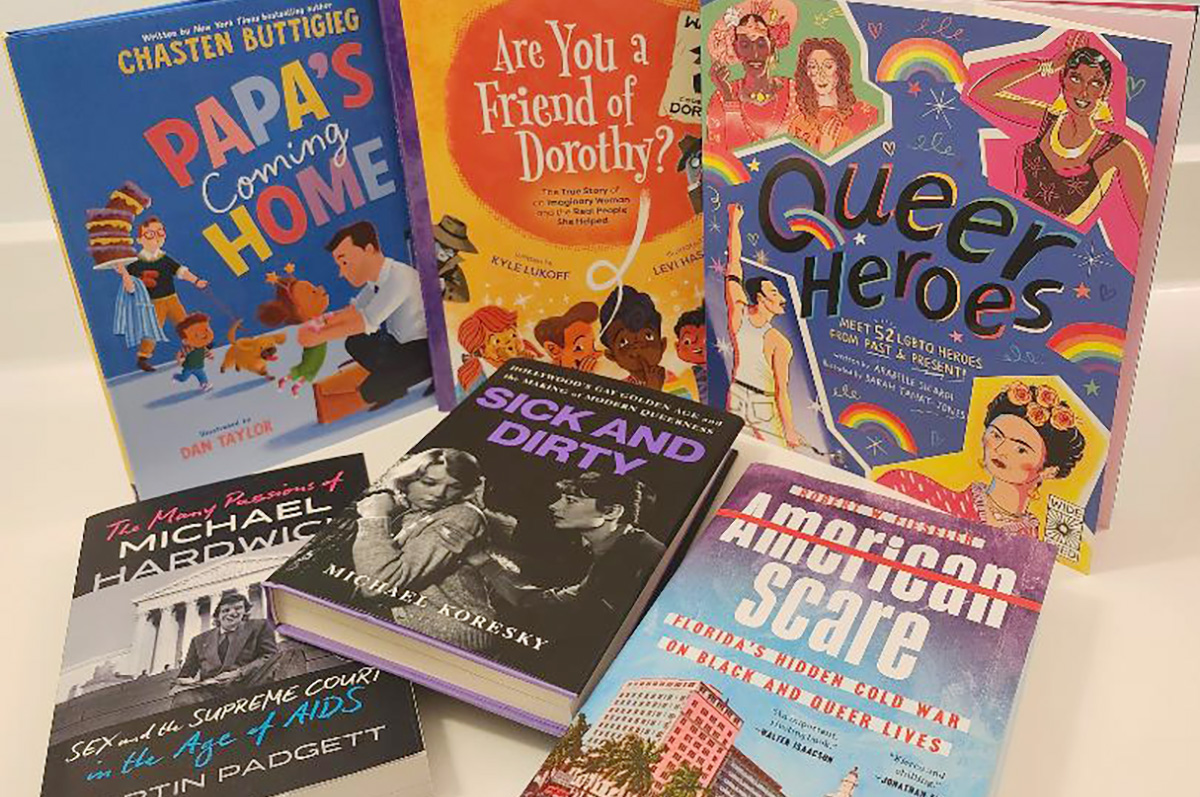
You’ve done your share of marching.
You’re determined to wring every rainbow-hued thing out of this month. The last of the parties hasn’t arrived yet, neither have the biggest celebrations and you’re primed but – OK, you need a minute. So pull up a chair, take a deep breath, and read these great books on gay history, movies, and more.
You probably don’t need to be told that harassment and discrimination was a daily occurrence for gay people in the past (as now!), but “American Scare: Florida’s Hidden Cold War on Black and Queer Lives” by Robert W. Fieseler (Dutton, $34) tells a story that runs deeper than you may know. Here, you’ll read a historical expose with documented, newly released evidence of a systemic effort to ruin the lives of two groups of people that were perceived as a threat to a legislature full of white men.
Prepared to be shocked, that’s all you need to know.
You’ll also want to read the story inside “The Many Passions of Michael Hardwick: Sex and the Supreme Court in the Age of AIDS” by Martin Padgett (W.W. Norton & Company, $31.99), which sounds like a novel, but it’s not. It’s the story of one man’s fight for a basic right as the AIDS crisis swirls in and out of American gay life and law. Hint: this book isn’t just old history, and it’s not just for gay men.
Maybe you’re ready for some fun and who doesn’t like a movie? You know you do, so you’ll want “Sick and Dirty: Hollywood’s Gay Golden Age and the Making of Modern Queerness” by Michael Koresky (Bloomsbury, $29.99). It’s a great look at the Hays Code and what it allowed audiences to see, but it’s also about the classics that sneaked beneath the code. There are actors, of course, in here, but also directors, writers, and other Hollywood characters you may recognize. Grab the popcorn and settle in.
If you have kids in your life, they’ll want to know more about Pride and you’ll want to look for “Pride: Celebrations & Festivals” by Eric Huang, illustrated by Amy Phelps (Quarto, $14.99), a story of inclusion that ends in a nice fat section of history and explanation, great for kids ages seven-to-fourteen. Also find “Are You a Friend of Dorothy? The True Story of an Imaginary Woman and the Real People She Helped Shape” by Kyle Lukoff, illustrated by Levi Hastings (Simon & Schuster, $19.99), a lively book about a not-often-told secret for kids ages six-to-ten; and “Papa’s Coming Home” by Chasten Buttigieg, illustrated by Dan Taylor (Philomel, $19.99), a sweet family tale for kids ages three-to-five.
Finally, here’s a tween book that you can enjoy, too: “Queer Heroes” by Arabelle Sicardi, illustrated by Sarah Tanat-Jones (Wide Eyed, $14.99), a series of quick-to-read biographies of people you should know about.
Want more Pride books? Then ask your favorite bookseller or librarian for more, because there are so many more things to read. Really, the possibilities are almost endless, so march on in.





